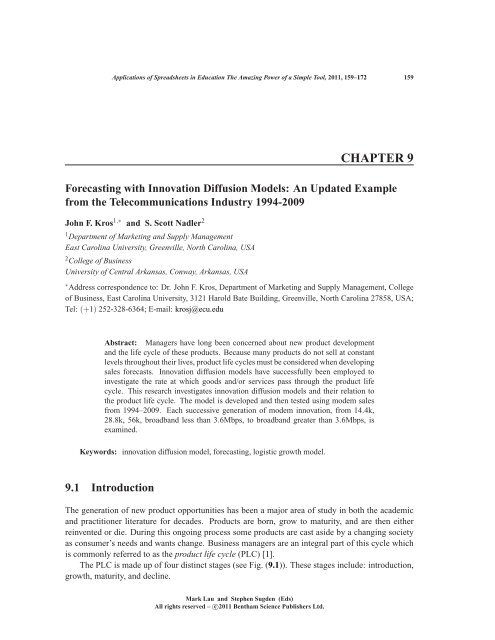chapter 3 - Bentham Science
chapter 3 - Bentham Science
chapter 3 - Bentham Science
Create successful ePaper yourself
Turn your PDF publications into a flip-book with our unique Google optimized e-Paper software.
Applications of Spreadsheets in Education The Amazing Power of a Simple Tool, 2011, 159–172 159<br />
CHAPTER 9<br />
Forecasting with Innovation Diffusion Models: An Updated Example<br />
from the Telecommunications Industry 1994-2009<br />
John F. Kros 1,∗ and S. Scott Nadler 2<br />
1 Department of Marketing and Supply Management<br />
East Carolina University, Greenville, North Carolina, USA<br />
2 College of Business<br />
University of Central Arkansas, Conway, Arkansas, USA<br />
∗ Address correspondence to: Dr. John F. Kros, Department of Marketing and Supply Management, College<br />
of Business, East Carolina University, 3121 Harold Bate Building, Greenville, North Carolina 27858, USA;<br />
Tel: (+1) 252-328-6364; E-mail: krosj@ecu.edu<br />
Abstract: Managers have long been concerned about new product development<br />
and the life cycle of these products. Because many products do not sell at constant<br />
levels throughout their lives, product life cycles must be considered when developing<br />
sales forecasts. Innovation diffusion models have successfully been employed to<br />
investigate the rate at which goods and/or services pass through the product life<br />
cycle. This research investigates innovation diffusion models and their relation to<br />
the product life cycle. The model is developed and then tested using modem sales<br />
from 1994–2009. Each successive generation of modem innovation, from 14.4k,<br />
28.8k, 56k, broadband less than 3.6Mbps, to broadband greater than 3.6Mbps, is<br />
examined.<br />
Keywords: innovation diffusion model, forecasting, logistic growth model.<br />
9.1 Introduction<br />
The generation of new product opportunities has been a major area of study in both the academic<br />
and practitioner literature for decades. Products are born, grow to maturity, and are then either<br />
reinvented or die. During this ongoing process some products are cast aside by a changing society<br />
as consumer’s needs and wants change. Business managers are an integral part of this cycle which<br />
is commonly referred to as the product life cycle (PLC) [1].<br />
The PLC is made up of four distinct stages (see Fig. (9.1)). These stages include: introduction,<br />
growth, maturity, and decline.<br />
Mark Lau and Stephen Sugden (Eds)<br />
All rights reserved – c○2011 <strong>Bentham</strong> <strong>Science</strong> Publishers Ltd.

















